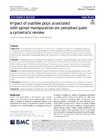| dc.contributor.author | Moorman, Annelieke Cesanne | |
| dc.contributor.author | Newell, Dave | |
| dc.date.accessioned | 2023-03-08T15:27:52Z | |
| dc.date.available | 2023-03-08T15:27:52Z | |
| dc.date.issued | 2022-10-04 | |
| dc.identifier.citation | Moorman, A. C., & Newell, D. (2022). Impact of audible pops associated with spinal manipulation on perceived pain: a systematic review. Chiropractic & manual therapies, 30(42). https://doi.org/10.1186/s12998-022-00454-0 | en |
| dc.identifier.issn | 2045-709X | |
| dc.identifier.uri | https://aecc.archive.knowledgearc.net/handle/123456789/181 | |
| dc.description | Available under License - Creative Commons Attribution: https://creativecommons.org/licenses/by/4.0/ | en |
| dc.description.abstract | Objectives
An audible pop is the sound that can derive from an adjustment in spinal manipulative therapy and is often seen as an indicator of a successful treatment. A review conducted in 1998 concluded that there was little scientific evidence to support any therapeutic benefit derived from the audible pop. Since then, research methods have evolved considerably creating opportunities for new evidence to emerge. It was therefore timely to review the evidence.
Methods
The following electronic databases were searched for relevant studies pertaining to the impact of audible pops in spinal manipulative therapy: PubMed, Index to Chiropractic Literature (ICL), Cumulative Index to Nursing & Allied Health Literature (CINAHL) and Web-of-Science. The main outcome was pain. Two reviewers independently selected studies, extracted data, and assessed risk of bias and quality of the evidence using the Downs and Black checklist. Results of the included literature were synthesized into a systematic review.
Results
Five original research articles were included in the review, of which four were prospective cohort studies and one a randomized controlled trial. All studies reported similar results: regardless of the area of the spine manipulated or follow-up time, there was no evidence of improved pain outcomes associated with an audible pop. One study even reported a hypoalgesic effect to external pain stimuli after spinal manipulation, regardless of an audible pop.
Conclusions
Whilst there is still no consensus among chiropractors on the association of an audible pop and pain outcomes in spinal manipulative therapy, knowledge about the audible pop has advanced. This review suggests that the presence or absence of an audible pop may not be important regarding pain outcomes with spinal manipulation. | en |
| dc.language.iso | en | en |
| dc.publisher | Chiropractic & Manual Therapies | en |
| dc.subject | Spinal manipulation | en |
| dc.subject | Audible pop | en |
| dc.subject | Pain | en |
| dc.subject | Systematic review | en |
| dc.subject | Chiropractic | en |
| dc.title | Impact of audible pops associated with spinal manipulation on perceived pain: a systematic review | en |
| dc.type | Article | en |
| dc.identifier.doi | https://doi.org/10.1186/s12998-022-00454-0 | |
